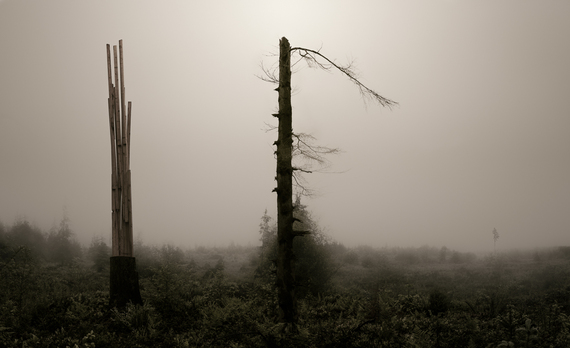
The scope of human alterations to our environment reaches far beyond the rainforests and coral reefs we've halved. We have also radically transformed our daily surroundings, increasingly forsaking our physical environment altogether, in favor of a digital-only space.
Just as we've removed trees for lumber and space with ruthless efficiency, so too, our advanced digital tools have broadened and flattened our psychic landscape in a clear-cutting of its own kind.
But something in us is still able to register discomfort when we see that a local green belt -- maybe even a green belt we never would have explored ourselves -- has been stripped bare and awaits development. We suspect that eliminating nature entirely isn't so good, so we try to preserve a bit here, return a bit there. In our digital environments, we also seek approximate ways to recapture the sensory richness and connectivity of real life with social networks, vast multi-player games, dating apps, virtual reality, messaging, video, blogs, and pornography and graphic violence to try to create a more complex, messier human experience amongst the 1's and 0's.
If there is one thing I've learned in the last two years immersed in the start-up world, it's that humans in a capitalist-driven, consumption-based economy love to turn to technology to solve problems created by technology. We package peeled oranges in plastic containers; outsource caretaking of those in our care, replant nature to replace nature there before. We take a tree and put back a tree. Whether we have ever made a forest is unclear.
* * * * *
But to recreate a forest, let's start with the tree. I recently collaborated with artist Joe Freeman on A Means to an End, Method 4.0, a photograph that documents the moment of trying to rebuild a tree in the middle of a vast clearcut in Washington state. It captures nature's inertia cleaved to entrepreneurial problem-solving energy.
Joe is an artist who has been exploring, for almost two decades, the existing and imagined terrains affected by human development. His recent work explores how nature tries to heal, and he continually emphasized that it simply takes time. Joe and I have very different practices at this moment, and A Means to an End, Method 4.0 is charged with energy from that difference. His considered, meticulous and methodical approach collides with my rapid prototyping, iterative design methods. I wondered if there was a faster way, a hack, to rebuild a tree.
A Means to an End, Method 4.0 is a 25 minute solution to "return the wood material back," "construct a tree," and "solve deforestation." In 25 minutes with building momentum, I urged Joe to keep going higher, and not to hesitate in the perfect placement. The 2x4's reach upwards, a little wobbly, a bit haphazard, but very upright. Wood + verticalness = some approximate definition of a tree we can get credit for, right? Sure, we had to take a few shortcuts, but maybe it could be a temporary scaffold until nature gets a better foothold? Or maybe it's just the bare minimum, "legal-ish" definition of a tree, in the same way that companies adhere to regulations, technically following laws, not the spirit of the undertaking.
And so, it's a tree, but not a tree. It's a solution, but not a real, sustainable solution. Right next to it is a tree that stopped growing, the same height. The juxtaposition makes one wonder -- which tree is more a tree? Or which tree is more useful? Which is actually more dead?
The image offers the earnestness of the entrepreneurial can-do spirit with the humbling afterthought that we really don't have a practical, scalable, immediate solution. With the breakneck speed of information and action, immediate solutions are seductive. We know how to deliver food faster and more conveniently to people who have the means to get foods in nineteen different ways, but we don't know how to equitably distribute food even locally. We know how to scalably create tree farms for lumber, but there are few shortcuts to re-establishing a forest. These problems won't be solved by the private sector, whose fiduciary responsibility is towards its investors, whose accountability is in a few years, not a generations, and whose primary mode of operation is competitive, not collaborative.
Still, we need a Hail Mary solution for the breakdown in the balance between consumption and regeneration, and progress looks forward. With optimism, even if naive, misguided or overreaching, we never stop trying. And there is something to that spirit, which is fundamentally human.
The print is large -- from far away, it appears bleak, a black and white image drained of color, hazy, gray. But as you get closer, you realize it is actually in color, that the underbrush is a lush rich, multi-variegated green, and the wood is a dark dark brown. There is life when there doesn't seem to be. There is hope but you have to get close enough to notice. And in the far right, away from the clearcut, is a tree that offers an example of what we really aspire to when we say "tree." It's hazy, it's far off, but it's there offering a guidepost to treeness within a sense of time and scale.
Photo Credit: Joe Freeman